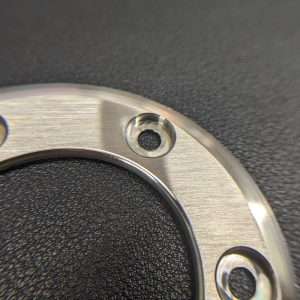Stainless Steel Machining
High mechanical strength, Thermal, Wear, and Corrosion resistance. Stainless steel is low-cost and can be machined easily. Parts made from Stainless steel are durable and do not lose that strength over time.

All uploads are secure and confidential.
Stainless Steel At a Glance
| Process compatibility | Applications | Alloys | Tolerances | Wall Thickness | Max Part Size | Strengths | Lead Time | Price |
| CNC Mill CNC Lathe | Parts for construction, automotive, aerospace, defense, hardware, and tool sectors, which requires excellent corrosion resistance. | Stainless Steel 201 Stainless Steel 301 Stainless Steel 303 Stainless Steel (304L) Stainless Steel (316L) Stainless Steel (410) Stainless Steel (420) Stainless Steel (440C) Stainless Steel (17-4 PH) | Not lower than ±0.125mm (±0.005″) based on the drawing ( ISO 2768). It can be adjusted for complex shapes. | Minimum 0.03″ (0.80 mm), but this can change depending on the alloy type and the proportion of the wall thickness to the linear dimension. | 200 x 80 x 100 cm | High mechanical strength, Thermal, Wear, and Corrosion resistance | Minimum 3 days. Not more than 10 days; for all complex parts. | $$$$ |
Introduction to Stainless Steel
Stainless steel contains carbon and chromium as alloying materials, significantly improving mechanical strength. It offers High tensile strength, corrosion, and thermal resistance.
Steel is easily machined and welded, allowing for the creation of many different shapes. It has extensive applications in the construction, automotive, aerospace, defense, hardware, and tool sectors, among many others.
The surface finish for stainless steel is simple and has a bright silver tone, making it aesthetically pleasing.
Precision Techniques in Stainless Steel Machining
Our commitment to High-Quality CNC Machining for Stainless Steel Components is a cornerstone of our services. We Emphasize precision and durability by employing advanced technology and skilled professional expertise in Stainless Steel CNC Machining Services. This commitment to excellence and a deep understanding of stainless steel positions us as a leading Stainless Steel CNC Machining Service Company. Their focus on delivering top-notch quality in every component showcases their unwavering dedication to meeting the high standards expected in industries relying on stainless steel parts.
Customization and Applications
Prolean specializes in Stainless Steel Prototype Machining Services for a wide range of industries, from automotive and automotive to consumer electronics. Our operators skillfully handle CNC Machining of Stainless Steel Materials provided by experienced engineers. Our expertise is particularly evident in Custom Stainless Steel Parts Manufacturing, catering to diverse Industrial Applications. This tailored approach in Stainless Steel Machining positions Prolean as a leader in the field, offering solutions that meet the specific needs of their clients with precision and efficiency.
Global Services and Online Accessibility
Our Global Stainless Steel CNC Machining Services are renowned for global outreach and accessibility. Our clients are from everywhere, the US, Europe, North America, India, and Africa. We have streamlined the process of obtaining Online Quotes for Stainless Steel CNC Machining Services, enhancing the convenience for clients worldwide. As a leading Online Stainless Steel CNC Machining Service Provider, Prolean offers a user-friendly platform that simplifies the process of sourcing customized CNC machining services, catering to diverse industrial needs with efficiency and precision.
Efficiency and Cost-Effectiveness
Prolean’s Expert Stainless Steel Machining Solutions stand out for their efficiency and cost-effectiveness. We excel in providing Fast Stainless Steel CNC Machining Services without compromising quality, balancing the precision and cost. Our commitment to Quality Assurance in Stainless Steel CNC Machining ensures top-notch outcomes for every project. Prolean’s Cost-effective Stainless Steel CNC Machining Solutions are transparent about Stainless Steel CNC Machining Cost and Price, making them a trusted and budget-friendly choice for clients needing precision CNC machining.
Get Your Parts Made Today
All uploads are secure and confidential.


